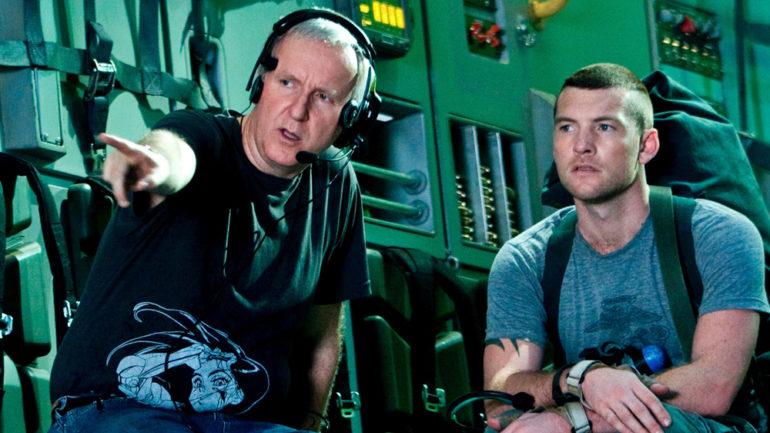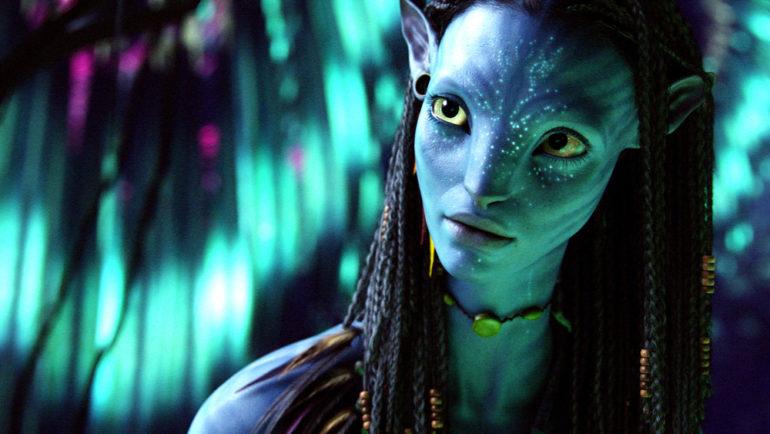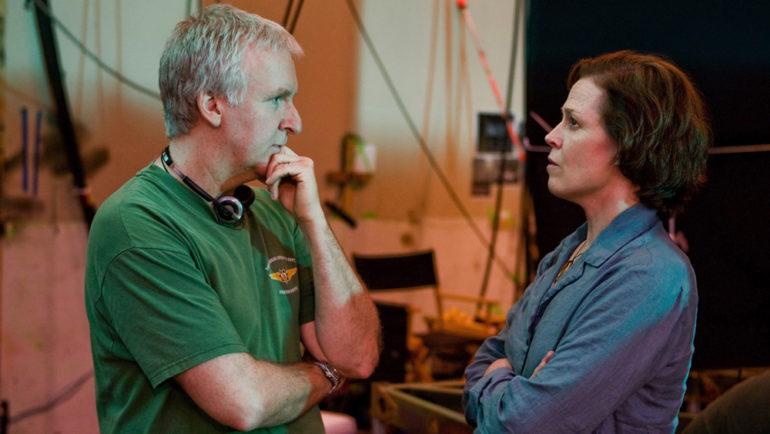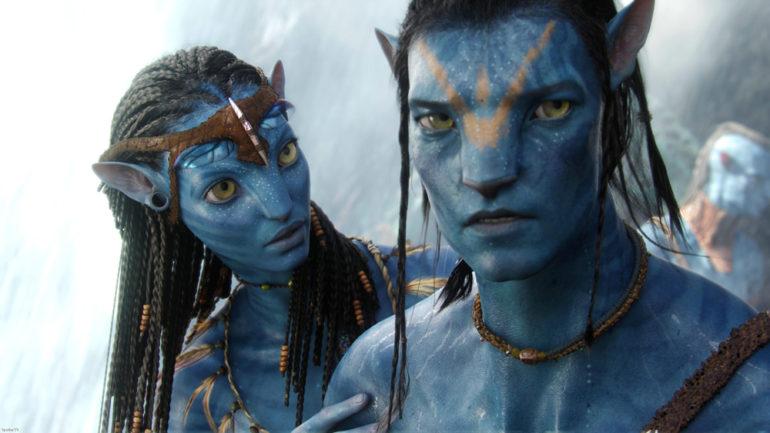‘Avatar’: James Cameron, Zoe Saldana, Sigourney Weaver Look Back a Decade Later
By Mackenzie Nichols
LOS ANGELES (Variety.com) – Filmmaker James Cameron had the idea for 2009’s “Avatar” brewing even before “Titanic” hit theaters in 1997. Born in Ontario, Canada’s tiny town of Kapuskasing, Cameron was inspired by the vast wilderness around him. Later, he took up scuba diving as a way of exploring the ocean. Those experiences in nature sparked his imagination and ultimately led to the creation of Pandora, the bucolic planet at the center of “.”
“Avatar,” the big-screen culmination of that childhood interest in the natural world, hit U.S. theaters on Dec. 18, 2009, becoming a box office phenomenon . For a decade, “Avatar” ruled the charts as the highest-grossing film of all time, raking in over $2.7 billion worldwide on around a $200 million budget and kicking off a boom in 3D filmmaking . The movie wasn’t just an entertaining ride (though it had its fair share of thrills), it also allowed Cameron to explore issues such as climate change, the colonization of indigenous worlds and the universal need for acceptance.
For those living under a rock who haven’t seen “Avatar,” it follows a wheelchair-bound Marine named Jake Sully (Sam Worthington) who is enlisted to help a team of scientists, army officers and corporate types obtain a rare mineral dubbed Unobtainium from the futuristic alien world of Pandora. Sully and other crew members, played by Sigourney Weaver and Joel David Moore, become “Avatars,” tall blue-bodied humanoids based on the natives, in order to adapt to the Na’vi culture. The Na’vi — including Sully’s Avatar — fight back against those trying to destroy their land in order to harvest the mineral. Sully’s loyalties are tested after he falls in love with one of the native Na’vi, Neytiri (Zoe Saldana).
The cast and crew talked to Variety about the making of the film.
wrote a 100-page “scriptment” in 1995, detailing the visual world of Pandora with certain scenes pulled out containing dialogue. He brought it to 20th Century Fox, but didn’t come back to the project for several years after “.” He needed the technology to catch up to his ambitious vision. He finally got the green light from Fox in 2006, the same year he finished the script.
Cameron: We did initial budgets and started to go into the digital feasibility in 1996 before we started “Titanic.” Then “Titanic” sort of took over my life for a couple of years. I didn’t really return to the project until I saw that there was significant advancements in facial performance in character and animation.
Jon Landau (producer): I went away and read it and I fell in love with it. When we were embarking on “Titanic,” I felt it was one of the last times an old-fashioned production was done with big sets and period costumes. We weren’t quite yet at the digital cusp. In reading “Avatar,” it was like, “Oh my god, that’s the whole next wave of what is possible in storytelling.”
Australian actor Sam
Worthington
, cast in the critical role of Jake Sully, had to go through two screen tests and audition on-set with , who was already cast in the role of Neytiri. Once Landau and Cameron saw his emotional range, he earned the part.
Landau: We actually put [Worthington] through the ringer. We had some little set pieces built and he played scenes with Zoe who we already cast as Neytiri and it was Sam’s ability to be play this vulnerable person at the beginning and the strength he was able to portray when he’s trying to rally these troops into battle, it was his ability to be able to span that range of performance that solidified it for us.
Cameron: I remember saying at the time, “That’s the guy that I would follow into battle, follow him into hell.” I wouldn’t follow those other guys. I think that was kind of the starting gun.
Zoe Saldana (Neytiri): I always felt like I had a connection with Sam [Worthington] from the beginning. From the first moment I met with him and I read with him, I felt like I was talking to Jake Sully.
Paul Frommer, a linguistics professor from USC, created the Na’vi language to “out-Klingon Klingon.” He incorporated various dialects such as Polynesian sounds, and various Native American, Inuit and African Bushman languages to come up with a way of communicating that was unique to the film.
Cameron: [Frommer] pulled together so many odd sounds that I didn’t feel the actors would be able to master it, so we dialed back on that and then we developed a kind of sound spectrum, a specific kind of a lexicon of basic phonemes and sounds. Then Margery Simkin, who was our casting director, got some tapes and some phonemes to test every actor with. And if the actors couldn’t do the sounds, they didn’t get cast.
(Grace Augustine): It’s a very unique language. It does use a lot of different vocalizations. I must say I was very grateful to have Paul around and also Carla [Meyer], our dialect coach. Zoe [Saldana] was so good at it. The amazing thing is that Jim, for this movie and for the ones we’re doing now, he invents every aspect of the movie itself. The language, the creatures, the plants, the landscape with the floating mountains and every single thing that you look at has been created by Jim. The language was yet another part of it.
The cast went to Hawaii to rehearse and connect with nature to prepare for their roles before filming commenced. Cameron wanted the actors to feel what it would be like to climb mountains, build fires and move through dense brushes.
Weaver: It was great for us as an ensemble to get to know each other and be with Jim so he could go on about all the aspects of Pandora and the story and the Na’vi people. We traveled with a botanist who was helping me learn how to be a xenobotanist studying alien plants. Joel [David Moore] and I would go into the forest on Kauai and we would take samples of the plants. Even though they were Earth plants, we tried to learn the technique — how to protect slides in the field and take pictures. Just training ourselves to see things as botanists. I think it was invaluable.
Cameron: was literally running around in kind of like a jockstrap, like a loincloth, and I mean he’s pure white. He hasn’t been in the sun in two years, he’s just pure white. He’s wearing this strap-on wig that looked ridiculous with kind of a chinstrap and he’s got a bow and arrow and he comes around a bend in the path or he’s running through a bush and he comes out onto the path and there’s a guy walking his poodle. And Sam just instinctively draws his bow and almost shoots the poodle. He was so in character. And the guy said, “What are you doing?” and Sam says, “We’re making a movie, mate!”
We spent about three days in the forest. We were cleaning fish, cutting fruits and preparing meals. Zoe [Saldana] cooked dinner in the ground one night. I think it was just invaluable for the actors to get a feeling of just how to move and what it would be like to live that close to nature.
Saldana: We were able to feel the earth and feel the rain and feel how cold it was and how slippery it was and how close you needed to be to the ground while you were running or jumping or doing whatever, and how difficult it is to start a fire in the rain. It was all of these things that by the time we got to set, we were approaching life as a Na’vi in a much more respectful manner. It was the best kind of research that Jim could have provided for us.
Cameron required his cast to imagine that the sound stages where they were doing much of the production were, in fact, dense rainforests and floating mountains. He used “performance capture technology” to film the actors and then digitally transform them into the blue-skinned, long-limbed Na’vi.
Landau: There’s not one frame of “Avatar” that is in a real jungle. We had the challenge of how do we allow the actors to experience a jungle, but then come back and sort of apply that same sense memory to a performance-capture stage in Los Angeles. From a design standpoint, for the Na’vis and the Avatars, we needed to make them relatable. It wasn’t a question of “Let’s create a cyclops look, lets create a vertical mouth.” We wanted them to feel alien, but relatable. We wanted audiences to be able to subconsciously recognize Zoe Saldana behind Neytiri, to see their performances come through.
Weaver: What I felt was fascinating was it was just like a big, empty stage. There was nothing in it except whatever they put in to represent what is in the virtual world. So they built us a kind of plank that we walked on above the forest floor and then there were sort of strange wooden extensions and things like that that represented trees.
It was amazing to see a roughed out version of your Avatar [on the screen] or your character if you were Na’vi. It showed you the scale of things and what the shot was and gave you input from the world so you could imagine the colors and you could imagine the forest or the mountain or whatever it was.
Saldana: It really helped to see sketches and the virtual location on screen because anything you could use to help you get to Pandora quicker in your mind and in your imagination was greatly appreciated. Jim was so generous, facilitating any kind of resource he could at our fingertips so that we just had what we needed to really make Pandora come to life.
Some of the most jaw-dropping scenes for Weaver involved the sequence where the Na’vi characters soar through the sky on their “Ikran” banshees. The bioluminescence of the world, including the jellyfish-like glowing “wood sprites,” left Landau in awe.
Weaver: We did have a wooden form not unlike a horse [for the Ikran] that would be up in the air and it was very practical and also certainly gave one the feeling of being free up in the sky and diving. We’re not going to float the actors up 30 feet in the air, but all of those movements could be experienced and captured not that far off the ground. We didn’t fly like Peter Pan, that all came later. But we had the experience, and we could watch that playback and see that we were zooming around mountains and plunging down waterfalls.
Saldana: Obviously at first you feel giddy because it’s a wooden artifact that your crew has built, but then once you get in it and Jim says “action,” you get that big fan on you and you’re in the scene. In the moment you lose sight and you feel like you’re in Pandora. We were on the torso, like the bodice of an Ikran, made out of fiberglass, and we would get on it and they would rig it and then they would move it and it was pretty unbelievable and awesome.
Landau: The bioluminescence and the scene when the “wood sprites” come down on Jake for the first time, I wanted to be there. I wanted to be out there on that planet looking up at these beautiful pulsating, glowing creatures coming down and surrounding me. The bioluminescence of the world was created by CG artists.
The black suits that the cast members donned every day of performance capture were comfortable and freeing. The helmets that they wore had two cameras facing them in order to see close-ups on-screen. Ultimately, performance-capture technology allowed for viewers to really see the actors as themselves, but in these new Na’vi bodies.
Weaver: [On the suit] we had a green stripe going down one side that did one thing and pink on the other and little bulbs that communicated different things. Those had to be put on very carefully. The suits themselves, once they were on, were pretty comfortable. We’d wear the helmet that had two cameras on it, both facing you. I can only imagine [they were] the least flattering shots in the world. [The cameras] were probably more to see our actual facial expressions close up, so they could then put them in the virtual world. Jim was very intent on showing that this was an actor-based technology and that nothing was going to be animated. It all came from the actors’ emotions, the actors’ movements, the actors’ facial expressions. I think the one discouraging thing was when the movie came, out people still didn’t understand — I’m not sure they still do — because people say to me, “Oh, so you’re going to voice another character” and it’s like “No, no.”
Saldana: Obviously at first I felt uncomfortable because the helmet is uncomfortable. You’re getting a headache with it. Your shoes don’t fit right. But as soon as you get to set and you start practicing everything you’ve been rehearsing so far and you’re working with Jim as your captain, it becomes an amazing form of performance capture.
Cameron isn’t done with Pandora. He’s planning at least three more sequels, the first one of which will open in December 2021.
Landau: We are going underwater, we’re on the water, we created a 900,000 gallon water tank where we could capture in, on and above the water. We trained our cast in breath holding and we’re excited to let people experience that.
Cameron: From 2013 until now we’ve mostly designed the whole world across four new movies. We’ve written, finished scripts for all four of those films. We’ve cast them, and we’ve [performance] captured movie 2, movie 3, and the first part of movie 4. We’re mostly done with the live action. I’ve got a couple months in New Zealand in spring, so we’re kind of on track with what we set out to do.
People don’t really understand the scope and complexity of the process. It’s like making two and a half big animated films. A typical big animated film takes about four years, so, if you do the math on that, we’re kind of right on schedule for December 2021.
From ecological exploitation to the importance of indigenous cultures, “Avatar” isn’t afraid to grapple with political issues.
Landau: The scene that I thought was poignant is when Jake Sully is accepted by the [Na’vi] tribe and he has paint on his face. And then the clan comes around and forms a circle around him to signal they’re accepting him. Someone that they once called an “alien,” they are now accepting. To me, we all want that acceptance. It’s like when you say in the movie “I see you,” it doesn’t mean I literally see you. It means, “I see who you are and I accept you for who you are.”
Cameron: My sources were the entire history of European civilization migrating into the new world, whether that new world was Australia or New Zealand or South America or North America. It’s an encapsulation of the colonial period. And basically, kind of the conquest of the new world at the expense of all the indigenous people. It’s a long, bloody history and I think everybody can see where the reference points are. But it’s also an environmental film and it makes the connection that our remaining indigenous people on this planet — especially in the rainforests — are kind of watchdogs and our guardians of nature. They’re our wisdom keepers. They know the correct way in which human beings should live in balance with their natural world.
I suppose if it really did a lot of good, we wouldn’t be in the jam we’re in right now. I mean, we’re not doing s–t about the climate, not at a rate that needs to happen.
After the film opened, Cameron and Landau said ethnic groups approached them to say that they saw themselves in the Na’vi.
Cameron: The film has done good in a sense that we got a tremendous amount of positive feedback both from the environmental community and from the indigenous community worldwide. We got drawn into a lot of indigenous affairs over the following few years and trying to be supportive of some of their causes, especially in the Amazon. I went down there a few times and got embroiled in some of those fights against the dams that were going to destroy tens of thousands of square miles of rainforests. But I look around now 10 years later and I just see the battle being lost at every single front in terms of biodiversity, deforestation, indigenous rights, loss of culture, loss of language, ocean pollution, rising ocean temperatures, all of these things. We’re just losing the battle at every front you look at. So we’re going to have to get a whole lot smarter in a whole lot shorter amount of time.
Landau: I was traveling after [the movie came out], [and] I had a thing that I was doing in Israel, it was my first trip to Israel. When I was there I met some Israelis, and they said to me, “Jon, I saw ‘Avatar’ and the Na’vi are us.” And the next day, I met some Palestinians, and the Palestinians said, “Jon, the Na’vi, they’re us.” And wherever we went, whether it was South America, whether it was in Asia, people identify with these characters, with these cultures and saw a little bit of themselves in the movie.




